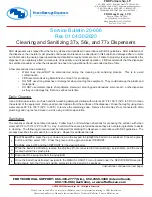
Operating Instr
uctions
Safety Instr
uctions
Customer Ser
vice
Tr
oubleshooting T
ips
Care and cleaning of the water softener system.
12
Breaking a Salt Bridge
Sometimes, a hard crust or salt bridge forms in the salt storage area. It is usually caused by
high humidity or the wrong kind of salt. When the salt bridges, an empty space forms
between the water and salt. Then salt will not dissolve in the water to make brine.
If the brine tank is full of salt, it is hard to tell if you have a salt bridge. Salt is loose on top,
but the bridge is under it. The following is the best way to check for a salt bridge.
Salt should be loose all the way to the bottom of the tank. Take a broom handle or like tool,
and carefully push it down into the salt, working it up and down. If the tool strikes a hard
object (be sure it’s not the bottom or sides of the tank), it’s most likely a salt bridge.
Carefully break the bridge with the tool. Do not pound on the walls of the tank.
If the wrong kind of salt made the bridge, take it out. Then fill the tank with nugget or pellet
salt only. In humid areas, it is best to fill with less salt, more often.
Push tool into salt
bridge to break
Pencil
mark
Broom
handle
Salt
Salt
bridge
Water
level
1
″
- 2
″
Clean the Nozzle and Venturi Assembly
A clean nozzle and venturi is needed for the water softening system to work properly.
This small
unit makes the suction to move brine from the salt storage area to the resin tank during
regeneration. If it becomes plugged with sand, dirt, etc., the water softening system will not
work and you will get hard water.
To get to the nozzle and venturi remove the water softening system top cover. Be sure the
water softening system is in service cycle (no water pressure at nozzle and venturi). Then,
while holding the nozzle and venturi housing with one hand, remove the cap. Lift out the
screen support and screen, then the nozzle and venturi. Wash and rinse the parts in warm
water until clean. If needed, use a small brush to remove iron or dirt. Also check and clean
the gasket.
NOTE:
Some models have a small flow plug located in the nozzle and venturi, and/or a small
cone shaped screen in the housing. Be sure to check and clean these parts, if your model is so
equipped.
Carefully replace all parts in the correct order. Lightly lubricate the o-ring seal with clean
silicone grease and place in position.
Install and tighten the cap, by hand only. Do not over-
tighten the cap or housing
.
Cap
O-ring seal
Screen
support
Screen
Screen
Nozzle &
Venturi
Nozzle &
Venturi
housing
Gasket
*Fill flow
plug
*Flow plug
IMPORTANT: Be sure small holes in
the gasket are centered directly
over the small holes in the nozzle
and venturi housing.
*Install with numbered side up,
concave side down.






































